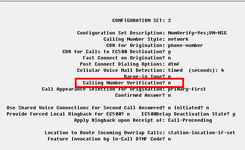SouthernKnight
Systems Engineer
We recently started moving some of our voice circuits from Verizon to Lumen. All of that itself is going fine. However, since we have moved we have noticed an oddity...
In the past, on the Verizon circuits, if a user with EC500 calls their own DID it would convert the inbound EC500 number to their internal extension. This would then drop them into their voicemail (Avaya Messaging) automatically (prompting for password), so that they could check their messages.
Since converting some of our offices to Lumen though, this is no longer working. The call rings at the extension and then goes onto coverage which then sends the call to voicemail as if they were a regular caller trying to contact them.
EC500 still works fine on outbound calls over Lumen, just as it did over Verizon.
Also, our normal Avaya Messaging pilot number, which is on Windstream (yes, I know...a 3rd circuit vendor), operate fine when someone calls it. In other words, it drops them into their mailbox and asks for their password.
The trace shows what is happening...the number is not being converted from the inbound CallerID to the associated extension for EC500. However, I am at a loss to see what to change. Lumen is sending 10 digits, just as Verizon and Windstream do. Is it perhaps something I am missing in the Configuration-Set?
Any help is greatly appreciated.
In the past, on the Verizon circuits, if a user with EC500 calls their own DID it would convert the inbound EC500 number to their internal extension. This would then drop them into their voicemail (Avaya Messaging) automatically (prompting for password), so that they could check their messages.
Since converting some of our offices to Lumen though, this is no longer working. The call rings at the extension and then goes onto coverage which then sends the call to voicemail as if they were a regular caller trying to contact them.
EC500 still works fine on outbound calls over Lumen, just as it did over Verizon.
Also, our normal Avaya Messaging pilot number, which is on Windstream (yes, I know...a 3rd circuit vendor), operate fine when someone calls it. In other words, it drops them into their mailbox and asks for their password.
The trace shows what is happening...the number is not being converted from the inbound CallerID to the associated extension for EC500. However, I am at a loss to see what to change. Lumen is sending 10 digits, just as Verizon and Windstream do. Is it perhaps something I am missing in the Configuration-Set?
Any help is greatly appreciated.


